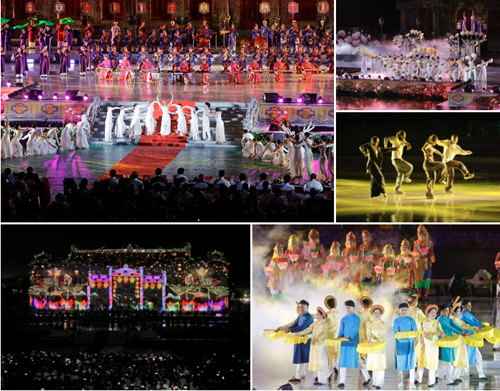Ancient capital, new experiences
One of the few places that preserves a vast collection of majestic palaces, citadels, and royal tombs, Hue is the only in Vietnam and Southeast Asia with eight UNESCO-recognized cultural heritage sites across multiple categories. Traditionally, the land used to be known as a quiet ancient capital, steeped in history. However, in recent years, the city has undergone a transformation, offering fresh experiences for visitors in a bustling tourism industry rich in heritage.
    |
 |
|
Thua Thien Hue expects to attract about 4.8 - 5 million visitors with activities and events held within the framework of the "Visit Vietnam Year - Hue 2025" and Hue festival. |
The highlight of 2024 at the Hue Imperial Citadel was the reopening of the Kien Trung Palace and Thai Hoa Palace after years of extensive restoration. Additionally, the Hue International Arts Festival Week took place with numerous events within the citadel, resulting in a 20% increase in associated ticket sales generating over 381.5 billion VND (14.99 million USD) as of November 20.
Visitors to the heritage complex were pleasantly surprised by many new features. “This is my second time in Hue. Apart from the restored palaces, I’ve noticed many new digital experiences that combine technology and reality. They help tourists understand more about the architecture, history, and artifacts on display. These experiences are trendy and appeal to today’s younger generation,” said Trieu Trang, a visitor from Hanoi, after using smart check-in technology through NFC chip-enabled boards at the Kien Trung Palace.
Last year, the local travel industry saw a significant revival, bolstered by a diverse array of heritage tourism offerings. The locality has successfully maintained the momentum of its positive recovery through a series of year-round festival events, forming and leveraging its identity as a city of festivals, culinary delights, and Ao dai (Vietnamese traditional long dress). Key new attractions include the opening of the Hai Van Quan relic site and the launch of the Hue-Da Nang tourist train.
Additionally, Hue focused on promoting and marketing the sector by participating in promotional programs in the U.S. and Canada to showcase its attractions, draw investment, and foster economic and trade partnerships with the two countries. For the first time, it was ranked among the top eight most affordable travel destinations in Asia, according to Agoda.
The number of visitors to the locality in 2024 was estimated at 4 million, including 2.7 million domestic holidaymakers, 26% higher than the 2023 figure. As a result, the total local revenue from tourism was projected to reach 8.5 trillion VND. While these figures reflected positive growth, the city still lags behind major ones like Da Nang, Ho Chi Minh City, and Hanoi, and even emerging destinations such as Quang Binh, Quang Nam, and Quang Ninh provinces in terms of tourism development.
"Taking off" with cultural heritage
Within its five-year socio-economic development plan (2021-2025), the ongoing year is set to see the city take off with the development of service industries. The city plans to diversify high-value service sectors, mobilize investment resources to develop tourism, and position it as a leading economic sector. The guiding principles are "distinctive products - professional services - simple, convenient procedures - competitive prices - clean and beautiful environment - safe, civilized, and friendly destinations."
In addition, it will expand the development of heritage tourism linked to the Complex of Hue Monuments, the Imperial Citadel, and other heritage sites in the area.
For a unique destination like Hue, its heritage has already brought immense value, giving it a distinctive edge in tourism. The revenue generated from tourism will also contribute to the preservation of the heritage. The challenge ahead is to achieve balanced development between tourism and conservation work while maximizing potential.
Building Hue’s image as a green destination to expand tourism will involve the use of bike stations, electric sightseeing cars and buses, as well as the creation of a waste-reduction tourism model centered out of facilities in Thuy Bieu ward.
According to Nguyen Van Phuc, Director of the municipal Department of Tourism, one of the upcoming tasks is to accelerate the implementation of the local green tourism action program for 2023-2025, with the goal of establishing a "green, clean, beautiful, civilized, and friendly" destination. Its tourism sector aims to attract 4.8 to 5 million visitors this year, with domestic tourists making up 55-60%. Total tourism revenue is expected to be about 68 trillion VND.
To this end, Hue will collaborate with the Ministry of Culture, Sports, and Tourism to host the National Tourism Year 2025. Additionally, it aims to promote direct flights with both domestic and international markets, including Quang Ninh, Hai Phong, Can Tho, Nha Trang, Quy Nhon, Phu Quoc, Thailand, Japan, and the Republic of Korea. The city will also strengthen partnerships with major travel agencies in traditional and emerging markets, as well as attract cruise tourists, chartered flights, and train services.
It will prioritize the development of unique products, including marine and lagoon tourism, community-based tourism linked to local crafts, culinary tourism, cultural exploration, as well as spiritual and wellness tourism. Hue will also push forward with digital transformation, focusing on smart management, experiences, and promotion, while building a comprehensive system to digitalize tourism data.
Another area of focus to help generate increased and sustainable tourism numbers includes the development of related transport connectivity infrastructure. Greater attention will be given to key tourism projects such as Laguna Casino, Minh Vien Lang Co International Resort, along with various other resort and service areas.
Source: VNA